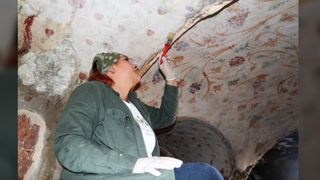
Restorative work reveals the designs painted on the stone-cut tombs' ceilings. (Image credit: Blaundos Archaeological Excavation Project Archive)
Archaeologists in Turkey have discovered 400 rock-cut chamber tombs that date to 1,800 years ago and make up part of one of the largest rock-cut chamber tomb necropolises in the world.
The team found the tombs in the ancient city of Blaundos (also spelled Blaundus), located about 110 miles (180 kilometers) east of the Aegean Sea in what is now Turkey. The city was founded during the time of Alexander the Great and existed through the Roman and Byzantine periods.
The tombs are filled with sarcophagi, many of which contain multiple deceased individuals — a clue that families used these tombs for burials over many generations, said Birol Can, an archaeologist at Uşak University in Turkey and head of the Blaundos Excavation Project.
"We think that the Blaundos rock-cut tomb chambers, in which there are many sarcophagi, were used as family tombs, and that the tombs were reopened for each deceased family member, and a burial ceremony was held and closed again," Can told Live Science in an email.
The city of Blaundos sits on a hill surrounded by a valley, which is actually a branch of the vast Uşak canyons, one of the longest canyon systems in the world, Can said. The people of Blaundos built the necropolis into the slopes of the canyon. "Due to the rocky nature of the slopes surrounding the city, the most preferred burial technique was the chamber-shaped tombs carved into the solid rocks," he said. READ MORE...
No comments:
Post a Comment